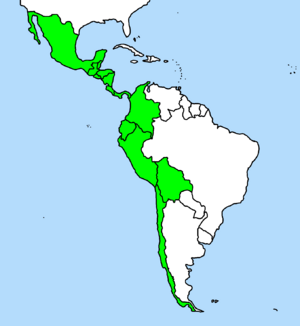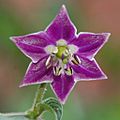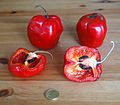Rocoto pepper facts for kids
Quick facts for kids Rocoto pepper |
|
|---|---|
 |
|
| Scientific classification | |
| Genus: |
Capsicum
|
| Species: |
pubescens
|
| Synonyms | |
|
|
| Rocoto pepper | |
|---|---|
| Heat | Low to Very hot |
| Scoville scale | 2,400- 250,000 SHU |
Capsicum pubescens is a special plant in the Capsicum family, which includes all kinds of peppers. Its scientific name, pubescens, means "hairy" because its leaves are covered in tiny hairs. This hairiness, along with its unique black seeds, helps you tell it apart from other peppers. The fruits of Capsicum pubescens can be yellow, orange, red, green, or brown, and they can be quite spicy!
You'll mostly find this pepper growing in Central America and South America. People eat it fresh, as a paste, dried, or ground into powder. In Peru and Ecuador, it's called rocoto. In Bolivia and Argentina, it's known as locoto. In Mexico, it's often called manzano pepper, which means "apple" in Spanish, because its fruit looks like a small apple. Out of all the different types of peppers grown by people, this one is the least common and the most different genetically.
Contents
About the Rocoto Plant
How it Grows
Like other peppers, Capsicum pubescens plants grow like a bush. Sometimes, they can even climb! They can grow into tall, woody plants up to four meters (about 13 feet) high. They can live for up to 15 years, which is a long time for a pepper plant. This makes them look almost like small trees when they get older.
The plant first branches out when it's about 30 centimeters (12 inches) tall. As it grows, it keeps branching, making it look very bushy. New shoots also grow from where the leaves meet the stem. Some types of these plants have purple spots on their branches, just like some other pepper plants. The leaves are oval-shaped, about 5–12 cm (2–5 inches) long and 2.5–4 cm (1–1.5 inches) wide.
Its Flowers
The flowers of the rocoto plant usually grow alone or in pairs on the branches. They have short stems, about 1 cm (less than half an inch) long, which get longer when the fruit grows. A special thing about these flowers is their beautiful blue-violet petals, which are brighter in the middle. The parts inside the flower, called anthers, can be purple or white. This blue-violet color is different from other common pepper flowers.
What Makes it Spicy and Smell Good
Spiciness (Capsaicinoids)
The heat you feel from chili peppers comes from natural chemicals called capsaicinoids. In most chili peppers, one chemical called capsaicin makes up most of the heat. But in C. pubescens, another chemical called dihydrocapsaicin is almost as strong.
The spiciness of C. pubescens can vary a lot. Some types are quite mild, while others are very hot! The heat level can range from 2,400 to 250,000 Scoville Heat Units. This means some rocotos are only a little spicier than a jalapeño, while others are as hot as a habanero!
Its Special Smell
People are becoming more interested in C. pubescens because it has a unique cucumber-like smell. Its scent is different from other chili peppers. The main smells are green, cucumber, earthy-peas, and a paprika or bell pepper scent. This is likely because it has more sulfur and nitrogen compounds and cucumber-like chemicals called aldehydes. Other peppers, like C. chinense, have more fruity smells, which are not as strong in C. pubescens.
How Rocoto is Used
In the Kitchen
The fruits of Capsicum pubescens are used in many ways in South American cooking. They have thick flesh, much like a bell pepper. The spice level can be very high, from 50,000 to 250,000 Scoville Heat Units.
Eating it Fresh
When preparing rocoto, it's a good idea to wear gloves because of how spicy it can be. The seeds and the white parts inside, where most of the heat is, are usually cut out. To make the pepper less spicy, you can boil the fruits.
Prepared rocoto chilies are used in many dishes. Rocoto relleno is a famous dish from Arequipa, a city in Peru. For this dish, hollowed-out and boiled rocotos are filled with a mix of ground beef, onions, garlic, and spices. It's then topped with cheese and baked in the oven. Rocotos are also added to other meals. You can make a chili paste by blending the peppers with oil. A chili cream can be made by mixing rocoto with fresh cheese. Aji de Huacatay is a green sauce with green rocoto chilies, often served with potatoes. Rocotos are also great for fresh salsas.
Using it Processed
Because rocoto peppers have thick flesh and a lot of water, drying them only with sunlight isn't as easy as with other peppers. Special drying tunnels are used to remove the moisture. For example, 80 kilograms (about 176 pounds) of fresh rocoto can be dried down to 6.4 kilograms (about 14 pounds) of dried rocoto.
Where Rocoto Comes From
Capsicum pubescens first grew in Bolivia, Peru, and Ecuador, even before the Inca times. Scientists have found signs of it in ancient caves. Old Peruvian cultures like the Paracas and Nazca also showed rocoto in their art and textiles. It's thought to be one of the oldest plants grown by people in the Americas, possibly as far back as 6000 BC.
This pepper is believed to have developed from other wild pepper types in the same area. It's quite different from other types of peppers grown by people and doesn't easily mix with them. In the early 1900s, Capsicum pubescens was brought to Indonesia, where it's now grown alongside other peppers.
Outside of Central and South America, Capsicum pubescens is not very common. It's mostly grown in small gardens by families, and any extra peppers are sold in local markets.
Rocoto plants can grow in higher, cooler places than other peppers. They can't handle very hot tropical weather or frost. They need a long growing season, about nine months. These climate needs make it hard to grow them in many other places around the world.
Growing Rocoto Peppers
Planting and Care
C. pubescens is special because it's the only pepper that can handle cooler temperatures. It likes a clear temperature difference between day (around 15 °C or 59 °F) and night (around 8 °C or 46 °F). This is similar to the mountain regions where it naturally grows. However, both frost and very high heat can harm the plants.
Farmers often start rocoto plants in a nursery for about 1 to 1.5 months, usually in early February. Then, they plant them in the fields around March, when there's no risk of frost. After planting, or after the plant starts branching or flowering, farmers add nutrients like potassium, magnesium, and zinc. This is usually done every two months after harvesting begins. Some farmers grow C. pubescens near other plants like tea trees or C. annuum (bell peppers).
Plant Problems
Pests
In Europe, rocoto plants are quite good at resisting pests. However, in other places, C. pubescens can be a host plant for the Anastrepha ludens, also known as the Mexican fruit fly. This fly is a very serious pest that can cause a lot of damage to crops. Because of this, many countries limit the import of fresh C. pubescens to prevent the spread of this fly. Only frozen or processed rocoto foods are usually allowed in places like Europe.
Diseases
Rocoto plants are also resistant to several diseases. One important disease they resist is caused by a tiny organism called Phytophthora capsici. This disease causes huge losses in pepper farms worldwide, costing over $100 million each year. C. pubescens has a thick, waxy outer layer that can peel off during infection. This is sometimes called "peeling peeling" disease in areas like Oxapampa, Peru.
Harvesting the Peppers
It takes at least three months for C. pubescens fruits to ripen after the flowers bloom. Harvesting usually starts 3 to 8 months after the plants are moved to the fields. Farmers collect the fruits every week or two. A single plant can keep producing peppers for 2 to 3 years, and sometimes even up to 5 years, before diseases might stop it. Each plant can produce about 0.5 kg (about 1 pound) of peppers per harvest, with up to 40 chilies from a one-meter-tall plant.
Gallery
See also
 In Spanish: Capsicum pubescens para niños
In Spanish: Capsicum pubescens para niños








